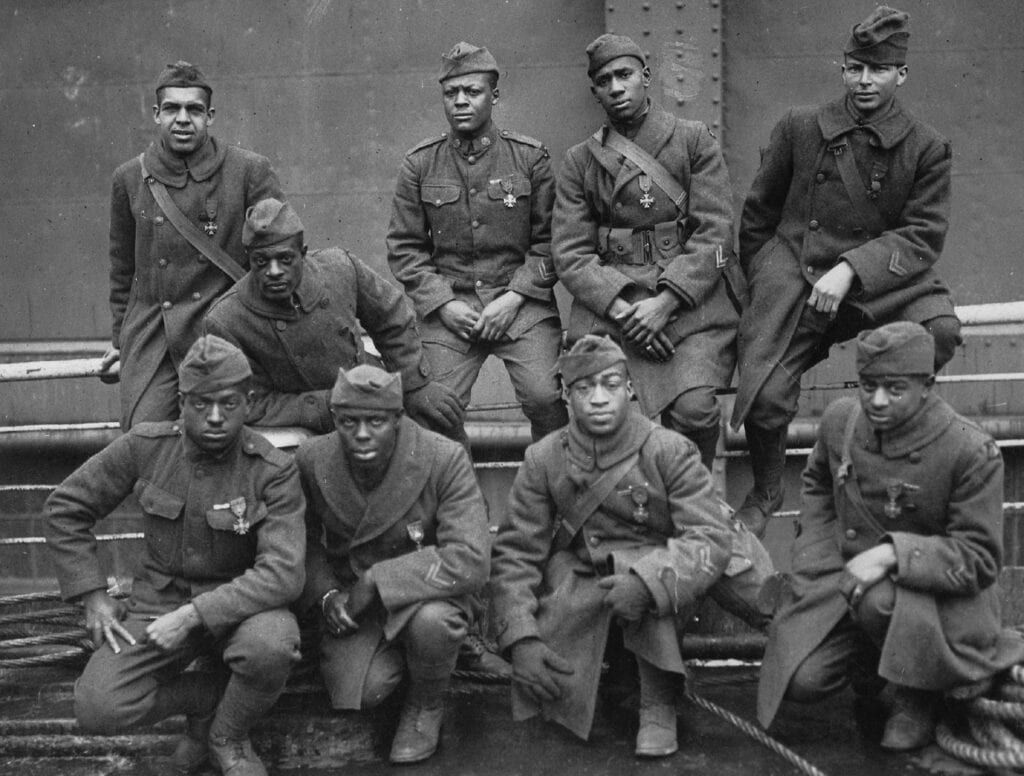
Photo: Some of the men of the 369th (15th N.Y.) who won the Croix de Guerre for gallantry in action.” Left to right. Front row: Pvt. Ed Williams, Herbert Taylor, Pvt. Leon Fraitor, Pvt. Ralph Hawkins. Back Row: Sgt. H. D. Prinas, Sgt. Dan Strorms, Pvt. Joe Williams, Pvt. Alfred Hanley, and Cpl. T. W. Taylor. 1998 print. Records of the War Department General and Special. Staffs. By an unknown photographer / Public domain
The Harlem Hellfighters was the nickname given to the 369th infantry and was based in East Harlem. Made up of African Americans, they volunteered for service during WW1 as a group. The men answered the call to serve. The theory was that if they served their country they would get the respect and the same rights as their fellow citizens. Unfortunately, the accolades and respect after the war were short lived.
In my Volunteers series I write about people or events that were under reported in their time and are now a footnote in history. In the first book in the series Drive, I focused on the Rough Riders. The all-volunteer cavalry was manned by the sons and nephews of the Gilded set. I was fascinated by reports of heirs to massive fortunes running up San Juan Hill, pistols in hand.
For Harlem Rhapsody I chose the 369th. Despite racism and discrimination, these men changed the course of The Great War. As black men in the early years of the past century, the 369th were faced with seemingly insurmountable odds. They were not permitted to train with the white troops. Sent to Spartanburg S.C. to train they were spit on, segregated and kept out of coffee shops, hotels and restaurants. They trained with inferior equipment and second hand uniforms. Once they were shipped overseas their assignment was to clean out commodes. Commanding officer William Hayward relentlessly petitioned for them to see action. Soon the French troops were so depleted the 369th was sent to the front lines.
The 369th became the Harlem Hellfighters shortly after. The Germans gave them the name since the 369th fought like hell. They served 191 consecutive days in intense battle. The most intense time on the lines came during the Meuse-Argonne offensive. The conflict was a massive battle to push the Germans out of northern France. The allied victory in this offensive came in late September of 1918. The war ended shortly after.
The Hellfighters distinguished themselves during the offensive by taking the town of Sechault. Sechault was a sleepy French farm village before the war. It was the last hold out for the Germans by the end of it. The town had a number of two story buildings the Germans were using for snipers to protect their retreating troops and their supply lines. To win the offensive Sechault had to be taken. The Hellfighters were sent in.
Details are hard to find, but I dug up a few for my novel. The Germans set up snipers with anti-infantry machine guns from the windows of the higher buildings. For many of the Hellfighters the approach to Sechault was a suicide mission. Many men were cut down before they could make it to the first building. From there it was hand to hand and man on man combat. Each building, every wall was an individual battle to the death.
The Hellfighters took the town. Then advanced more than 14 kilometers through the German lines against severe resistance and were the first allied troops to reach the Rhine. The war ended in November and the surviving Hellfighters were awarded the Croix de Guerre for heroic service by the French government.
Like the Rough Riders, many the Hellfighters left behind promising careers to answer the call to serve. Among the infantry were a number prominent musicians. Lieutenant James Europe was one of the most popular composers and band leaders of his day. His songs were playing on Broadway while he was hunched down in a trench in northern France. After being hospitalized for injuries from a chemical weapon attack, Europe formed the Hellfighters band. What a band!
Many of the member were established musicians in Harlem and across America. The played throughout Europe during the war. The sensation came when after a few marching tunes they started syncopating and playing with rhythm. The Hellfighters band introduced Jazz to Europe.
Mister Europe died shortly after the war but his legacy along with the Hellfighters has lasted since.
There is a statue honoring the 369th in Manhattan at 142nd Street and 5th Avenue. The memorial recognizes the infantries heroism during the battle of Sechault. The obelisk is not in an area with much foot traffic. In fact it is not far from the highway and when I went to visit there was not another soul to be found.
There has been a lot of controversy about statues lately. I would recommend moving the Hellfighters memorial downtown to the middle of Times Square. Ending a war and introducing jazz to the world deserves a larger stage.
